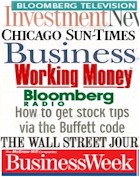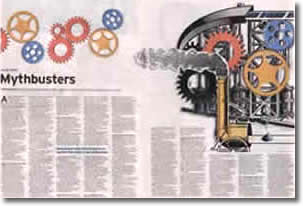Some
of these self-evident truths look fine on paper but are
destined to fail in the execution, because they don’t
take into account human frailty. Some are self-serving,
and others are self-evidently nonsense to begin with.
When
it comes to investing, there is no substitute for understanding
what you are buying and selling, why you are doing it
and how to best go about it. Being flexible rather sticking
to an approach that is plainly not working also helps.
Money
puts some popular market maxims to the test and busted
a few myths in the process.
Time in the market,
not market timing.
Everyone
agrees it’s impossible to time the market. In order
to take emotion and crystal ball gazing out of the investment
process, some professionals urge investors to ignore daily
market fluctuations and take a long-term view. This is
because over time growth assets such as shares and property
outperform other asset classes.
To
back up their claim, these professionals will often trot
out statistics showing that not being invested for just
a few of the best days dramatically lowers returns.
Foe
example, the US market produced an annualised return of
17.5 per cent in the 1980s, so an investment of $10,000
that stayed fully invested would grow to $50,162. But
an investor who had missed the best trading days would
end up with just $14,661.
Yet
no one ever talks about how you could beat the market
by missing the 40 worst trading days in the decade, even
though it is also self-evidently true.
The
problem with the “best and worst days” theory
is that most investors own a handful of shares and managed
funds which may perform better or much worse than the
index. Only index funds track the movement of the overall
market, so if your aim is to match the overall market
return, you can’t go past an index fund.
But
many personal investors aim to do better than the market,
especially when it is in free fall.
Market
educator, author and professional investor Colin Nicholson
says “time in the market” is a self-serving
theory most often used by fund managers who want investors
to give them money and stick with their investment.
“Time
in the market” may also be a convenient way for
fund managers to gloss over mismanagement, as if to argue
that risk doesn’t matter over the long term. But
a poorly managed fund or a dog stock is just as likely
to perform over the long term as the short term.
Nicholson
argues that investors can do better than “buy and
hold” without becoming traders or speculators. “If
the market is going down, down , down, you will be better
off out of the market,” he says
Every
legendary investor Warrem Buffett, well-known for holding
companies he likes for decades, is keenly aware of market
timing. The difference is that he is prepared to wait
patiently for the right price.
John
Price, who emulates Buffett’s investment methods
in his Conscious Investor trading program, says Buffett
bought a stake in Anheuser-Busch last year after keeping
an eye on it for 25 years. For Buffett, the right time
is when a great stock is offered at a price that will
produce the return he wants. Whether or not the stock
is at a short-term high or low is irrelevant.
Few
people possess Buffett’s skill especially when they
are just starting out, but he is proof that understanding
what you are investing in beats trying to second guess
the market.
You’ll
never go broke taking a profit
Followed
to the letter this seemingly self-evident truth could
easily lead investors astray and was myth that almost
everyone Money spoke to was keen to bust.
Nick
Renton says the “sell Half” dictum is commonly
used by brokers to disguise the fact that they don’t
what they’re talking about.
“If
you sell half and the stock price subsequently falls,
the broker says isn’t it good you sold some, and
if the price continues to go up, he says isn’t it
good yo only sold half.” Renton says.
John
Price says the problem with taking profits is that people
invariably put the proceeds back into a stock that underperforms
the one they’ve just sold, echoing the research
by Terrance ODean discussed above.
“Don’t
sell [your winners] unless you know what you are going
to do with the money and you’re confident the new
stock will do better than the one you just got out of,”
Price says
Nicholson
agrees. “Taking profits too soon is a good way of
never making money,” he says.
Even
professional investors are happy if six out of ten investments
are profitable. If you consistently take profits too early,
you won’t generate the returns necessary to cover
your losses.
“In
the long term, if you take small profits you won’t
do nearly so well as someone who buys into a good company
and sticks with it,” Nicholson says.
Price
believes setting an automatic stop/loss can create similar
problems. It is common practice among share traders to
set a price above and below their purchase price that
will trigger an automatic sale. This is designed to crystallise
profits and limit losses.
“[A
stop loss] sounds seductive, but most good stocks go down
for a period, and if you sell every time they go down
10 per cent, you will lose out,” Price says. His
philosophy is to use value as a uide and to buy and sell
as little as possible.
Overtrading,
sometimes called churning, is a common investor mistake
and only rewards stock brokers and advisors paid by commission,
not to mention the Tax Office. Share sold within 12 months
do not qualify for the 50 per cent capital gains tax discount.
Kerr
Neilson argues that setting a fixed percentage of profits
as a trigger to sell is a primitive way of adding discipline.
“You
should have a clear idea what a stock is worth in the
market. When the trend overshoots, then sell your position,”
he says.
Renton
also dislikes arbitrary targets. He argues that there
is no point selling a stock when it goes up by a specific
proportion if it still represents good buying. It may
go on to prices two or three time as high.
John Price is
CEO of Conscious Investing. Email: johnprice@conscious-investor.com 


